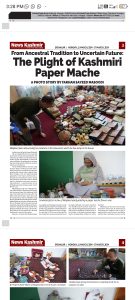From Ancestral Tradition to Uncertain Future:
The Plight of Kashmiri Paper Mache
A photo story by Farhan Sayeed Masoodi
The art of paper Mache has a long and rich history in Kashmir, dating back to the 14th century when it was first introduced by Mir Sayyid Ali Hamadani, a Daee who came to Kashmir from Hamdan in modern day Iran along with his followers, many of whom were craftsmen.
.
Maqbool Jaan showcasing his products in his showroom which he has setup in his house.
The art of Paper Mache involves using of paper pulp to make decorative items, these items once moulded into shape are painted with vibrant colours and intricate floral designs. This art quickly gained popularity in the region and became an integral part of Kashmiri culture and at the same time, it became a source of skill work for Kashmiris and some, an ancestral profession. Gowhara (sister in law of Maqbool jaan) painting a paper mache flower vase.
(In Progress Paper Mache of Maqbool Jan in his in-house workshop)
Maqbool Jaan, a 58-year-old Paper Mache artist from the Lal Bazar area of Srinagar, has been practising this traditional craft since the tender age of 3 years after his father died and he had to learn this craft for it to become his source of livelihood and earning. Despite never having gone to school, Maqbool Jaan says that he not only learned the art of paper mache but also received moral education at the workplace of artisans, which he considers to be his school. He is deeply passionate about his craft and believes that it has the potential to provide livelihoods to many in the region.
Maqbool jaan giving final touches to a painting made for an costumer on order.
However, artisans like Maqbool Jaan face significant challenges in today’s world. Mentioning his experience, Maqbool says that he once visited the Craft Development Institute (CDI) to discuss increase in wages, he says that at CDI he was mistreated by the authorities and even abused by one of the higher officials, who said to him that “we should keep the artisans under our feet.” This lack of support from government officials has contributed to the decline in the number of artisans practising paper mache, bringing their numbers to a few hundred.
Maqbool Jaan fears that the younger generation would not be interested in continuing the tradition due to lack of opportunities and financial instability and that the art of paper mache is at risk of dying out. He believes that the government should do more to promote traditional crafts like paper mache and encourage younger generations to take up the art form. In particular, he suggests organizing workshops in schools and colleges to attract the younger generation towards the craft.
Maqbool Jan sitting among his finished Paper Mache showpiece works.
Despite these challenges, Maqbool Jaan remains dedicated to his craft. Working alongside his wife, brother, and sister-in-law, he creates intricate and beautiful paper mache items in his home. One room is dedicated as the workplace and one as a showroom. The products are sold both locally and internationally, providing a source of income for Maqbool Jaan and his family.
Family of Maqbool jaan working in a room which they have dedicated as a workshop.
-
Maqbool Jaan’s story is a reminder of the importance of preserving traditional crafts and supporting the artisans who practice them. The decline of paper mache artisans in the region is indicative of a larger trend towards the extinction of traditional crafts. Therefore, the government must take steps to promote and preserve these crafts, ensuring that they continue to thrive for future generations.





